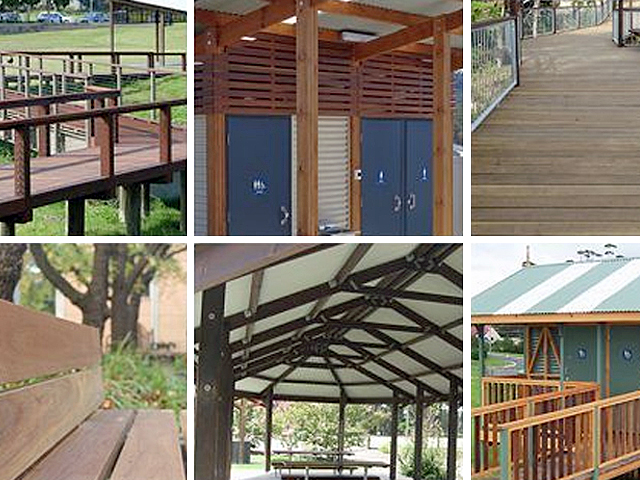REASONS WHY TIMBER IS STILL TOPS
Visit the Landmark factory and you will see one wall is filled with timber, ready to use on all types of products – from restrooms through to access structures.
Like soldiers in an army, the timber is ready to fulfil its purpose when needed.
Despite technology driving the rapid increase in building materials available, there are many reasons why timber remains the dominant player, particularly in public outdoor structures.
ADVANTAGES
Readily Available
In the financial year 2016-17, over 5.2 million m3 of sawn-wood timber was produced in Australia and 1.7 million m3 of wood-based panel. This represents $2.6 billion. As the most sparsely populated continent in the world, Australia is blessed with abundant forests, and over the years, has developed the expertise to harvest sustainably.
Landmark only source sustainably-harvested timber, where the chain of custody is proven and timber ethically harvested.
Safe
Since it comes from a natural source, timber is non-toxic. It is safe to handle and even as it ages, it will not cause damage to the environment, and can ultimately be easily recycled or repurposed.
Easy to Work With
Due to its lightness, density and grain structure, and the fact we have been using timber in buildings for centuries, we have highly developed machinery to cut, drill and prepare timber to the required size and shape, down to the finest detail. Even the toughest of hardwood timbers are relatively easy to work with compared to other building materials such as steel.
Cost Effective
As opposed to steel and aluminium, timber requires much less processing steps from raw material to final product and is therefore far more cost-effective. Also, in timber’s favour for cost-effectiveness is its durability.
Versatile and Visually Appealing
It is estimated that there are over 60,000 types of trees in the world. Combine this with the variety of stains which can bring out the character of the timber, and you have a mind-boggling array of possibilities for a building product.
Of course, Landmark only uses a relatively small array of timber for their open space structures – some for structural and others for visual effect, but if you are looking for a unique touch, the options available through the use of timber is still significant.
Naturally Anti-Corrosive
Unlike steel, timber does not corrode in salt air or heavy industrial environments. In a country like Australia with so many cities and townships on the coastline, it is often the definitive choice.
DISADVANTAGES
- As timber is natural and cellular it moves with changes in climatic conditions. Timber shrinks, swells, twists, cracks and bends over time and different climatic conditions.
- Most timbers are prone to pest, rot, mould and fungi attacks, some being less resistant than others.
- Timbers tend to silver or look old if left natural and unpainted.
- Timber maintenance can seem to be higher than other building materials.
SOLUTIONS
The good news is that all these disadvantages can be addressed, to ensure the open space structure remains strong, durable and attractive.
Selection of Timber
Using a select grade of timber (as Landmark Products provide) ensures you have the straightest, most consistent piece of timber available.
Application of Either ACQ or LOSP
For any timber that will spend its life in the great outdoors, the preserving qualities of either LOSP (light organic solvent preservative) or ACQ (alkaline copper quaternary) is ground zero to ensure protection from pests, fungus, mould and rot.
Application of Oil-Based Timber Protection
By applying a product such as Cutek Extreme Oil at the start and throughout the life-span of a product will significantly reduce splitting, cracking, warping and cupping.
Colours to Reduce Silvering
By maintaining the timber by periodically applying a new lick of Cutek, which is available in many colours, silvering can be reduced, and the original quality of the timber revitalized.
Maintenance, Maintenance, Maintenance
Timber maintenance can be demanding, but through careful timber selection and applying the right treatments, the workload can be reduced significantly. Did you know that because Cutek Extreme is oil based it can be easily reapplied with a rag or brush right over the existing coating, with no sanding or cleaning with toxic cleaning agents required?
Selecting the right timber, whether it is a softwood pine or hardwood, is important to ensure you get the correct visual grade.
Visual grading is the traditional method of determining a stress grade. In a visual grading process, a trained grader examines each piece of timber produced. This visual inspection is undertaken in accordance with either the hardwood or softwood visual grading standards, which define rules as to the types, sizes and positions of physical characteristics that are allowed into each ‘group’ or structural grade of material.
The grading process is reliant on the skill of the graders, with visual grading rules quite complex – there are over 20 different characteristics that need to be checked.
If you require any further help or information regarding which timber to select, or treatment to apply on timber give your local Landmark Project Consultant a call. Don’t forget to download our timber colour chart to see how your timber will look when it's finished!
Website
Send Enquiry To Landmark Products Pty Ltd
